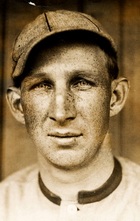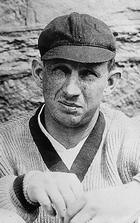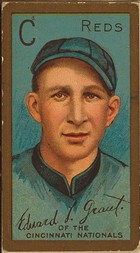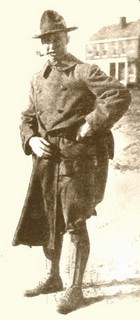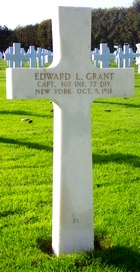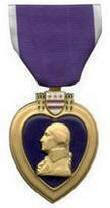Eddie Grant
| Date and Place of Birth: | May 21, 1883 Franklin, MA |
| Date and Place of Death: | October 5, 1918 Argonne, France |
| Baseball Experience: | Major League |
| Position: | Third Base/Shortstop |
| Rank: | Captain |
| Military Unit: | Company H, 307th Infantry Regiment, 77th Division US Army |
| Area Served: | France |
"Harvard Eddie" played nearly 1,000 major league games before serving his nation at the age of 33. His life was lost on the battlefields of France in 1918; the first former major league player to be killed in action in World War I.
Edward L. Grant was born on May 21, 1883, in Franklin, Massachusetts.
He attended Dean Academy (now Dean College) in Franklin for a year
before enrolling at Harvard University, where he played on the freshman
basketball and baseball teams. After playing varsity basketball at
Harvard his sophomore year in 1903, he was set to play varsity baseball
the following spring but was declared ineligible for playing
professional baseball in an independent league in Massachusetts the
previous summer.
Grant graduated from Harvard University in 1905 and continued to play
semi-pro ball with Lynn. He was given a trial with Cleveland in August,
after the club suffered a number of injuries. Making his major league
debut on August 4, 1905, Grant played second base against the Boston Red
Sox and got three hits in his team’s 7-5 loss. His second appearance was
not as successful as he struck out in each of his four at-bats and was
promptly released by the club.
In 1906, Grant was with the Jersey City Skeeters of the Class A Eastern
League and batted an impressive .322 in 86 games. Purchased by the
Philadelphia Phillies at the end of the season, Grant played 74 games at
third base in 1907 and batted .243. The following year he batted .244 in
147 games and led the National League with 598 at-bats. The next season,
1909, proved to be his best in the majors. Batting .269, he led the
league with 631 at-bats and 147 singles. In 1910, Grant played 152
games, batted .268 and had a career-high 67 RBIs.
The Phillies traded the 27-year-old to Cincinnati in November 1910, and
he played 136 games for the Reds in 1911, batting .223 with 53 RBIs and
28 stolen bases. 1912 saw him play 96 games and bat .239, playing mainly
shortstop. Grant started the 1913 season with the Reds but was traded to
the New York Giants in June and appeared in two games of the 1913 World
Series, once as a pinch runner and once as a pinch hitter. In 1914, aged
31, he played 88 games for the Giants and batted .277. He last season in
the major leagues was with the Giants in 1915, batting .208 in 87 games.
Over a career that spanned 10 seasons, Grant played 990 games and batted
.249.
After retiring from baseball, Grant practiced law in Boston. In the
summer of 1915, the “Plattsburg Idea” was implemented in order to
prepare the country for war. That year 1,300 prominent men - including
four Roosevelts and the mayor of New York City - enrolled in a summer
military training program in Plattsburg, New York. Eddie Grant was among
them. When the United States entered the war in April 1917, he was among
the first to enlist and served as a captain with the 307th Infantry
Regiment, 77th Division, going overseas to France on April 7, 1918. During the Meuse-Argonne offensive, all of
Grant's superior officers were killed or wounded, and he took command of
his troops on a four-day search for the Lost Battalion (nine companies
of the 77th Division, roughly 554 men, isolated by German forces).
During the search, an exploding shell killed Captain Grant on October 5,
1918. He was the first former major league player to be killed in action
in World War I.
"Eddie Grant . . . has played his last game of baseball," announced
Baseball Magazine. "He fell in the forefront, of an attacking column in
that desperate fight which cleared the Argonne forest of its German
invaders. Somewhere in France his grave is topped with a simple wooden
cross, the last eloquent tribute to the soldier dead. But the memory of
a brave man and a gallant gentleman will
adorn the annals of sport long after the wooden cross has crumbled
beneath the winds and ruins of that France he died to save."
On Memorial Day, May 29, 1921, representatives from the armed forces,
baseball, and the sisters of Grant unveiled a monument to his memory in
the outfield at the Polo Grounds (the plaque is replicated at AT&T Park,
home of the San Francisco Giants). He is also memorialized with the
Edward L. Grant Highway in the Bronx, New York, and by Grant Field at
Dean College. American Legion Post 75, Franklin, and Post 1225 in the
Bronx, New York,
were also named in his honor.
Eddie Grant is buried at the Meuse-Argonne American Cemetery in Romagne,
France. Plot A, Row 2, Grave 24.
Date Added July 11, 2012 Updated May 22, 2018
Baseball's Greatest Sacrifice is associated with Baseball Almanac
Baseball's Greatest Sacrifice is proud to be sponsored by

